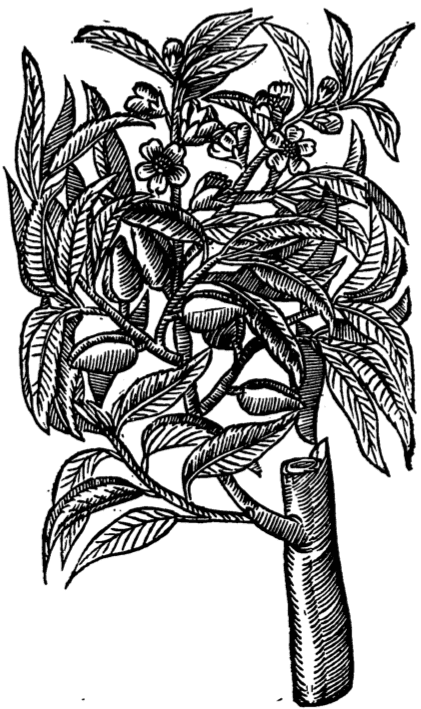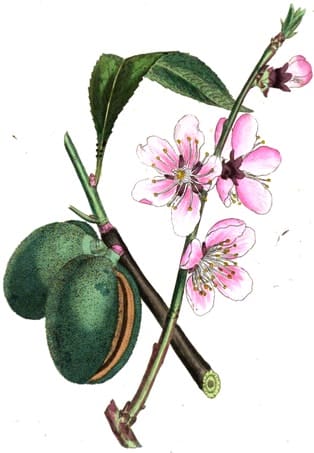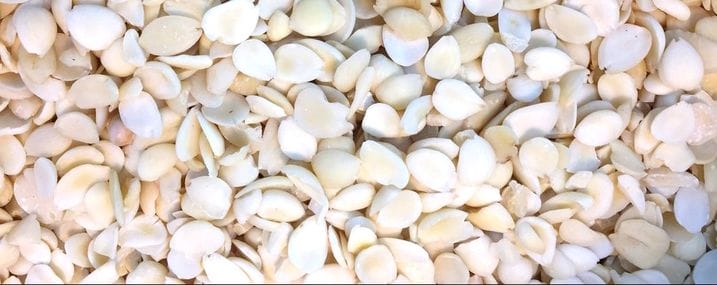Prunus amygdala dulcis, Sweet AlmondBadam (Unani) |

|

|

|
|
Parkinson, Theatrum Botanicum, 1640 |
Medical Botany, Woodville, Hooker, Vol. 3, 1832 |
 Apricot kernel (Xing Ren) (Adam, 2017)
Apricot kernel (Xing Ren) (Adam, 2017) Members CLICK HERE for the PRO VERSION
Members CLICK HERE for the PRO VERSIONBotanical name:
Prunus amygdalus dulcis (formerly Amygdalus communis)
TCM uses Apricot kernel Xing Ren synonymously: P. armeniaca, P. sibirica, P. mandshurica
Parts used:
Kernels; expressed Oil
Temperature & Taste:
Warm, Moist and Sweet
Classifications:
2L. EMOLLIENT
3L. ANTI-TUSSIVE. 3O. EMETICS (Oil)
4d. PECTORAL. 4j. NERVINE
TCM:
Q. Stop Cough and Wheezing
Uses:
1. Benefits the Yin and Qi:
-very nourishing; considered a powerful nutritive tonic for brain, nervous system, bones and flesh
-strenuous physical or mental activity, convalescence, and old age
-Almond Milk has been used as a substitute for animal milk.
-‘Increase Seed’; regarded as being a Mental Tonic and Aphrodisiac. (Unani, Ayurveda)
-Weakness, Wasting, Consumption
-Unani texts state it increases Vital Heat (Yang)
-‘strengthen the Nerves, provides a good Complexion’
2. Nourishes the Lungs, Stops Cough:
-Dry or Yin deficient type Coughs (West, TCM)
-Hoarseness, Coughs, Colds, Bronchitis, Asthma, Lung Ulcers and Pleurisy. (Almonds or Oil was given with Sugar)
3. Promotes Urine, Clears Stones:
-Oil has been given for Kidney and Bladder stones; also Colic.
4. Excess Appetite:
-‘Cures the Dog-like Appetite’. (Sennertus)
5. Externally:
-Almond meal is good as a cleansing facial scrub. The Oil is emollient.
Dose:
Decoction: 3–9 grams
Powder: 1–3 grams
As a health tonic, 5–7 can be taken each morning.
Correctives:
… available in PRO version
Substitutes:
… available in PRO version
Comment:
1. Chinese use of Apricot kernel (Xing Ren) is equivalent to the Western use of Almond kernel. The term ‘Xing Ren‘ can be used in Chinese for Almond and Apricot kernels. As with Almond, Sweet and Bitter varieties are used.

Main Combinations:
Almond & Licorice
1. Chronic Cough from Lung weakness:
i. Sweet Almonds with … available in PRO version
ii. Emulsion of Almonds for the Lungs: Blanched Almond (1 oz.), … available in PRO version
2. Pleurisy, Sweet Almond with … available in PRO version
3. Emulsion for Heat of the Kidneys and sharpness of Urine: … available in PRO version
4. Urinary Ulcers, Sweet Almonds with … available in PRO version
5. Marzipan against leanness and Lung diseases: Sweet Almonds blanched … available in PRO version
6. Aphrodisiac, Sweet Almonds with … available in PRO version
7. Back Pain, Sweet Almond with … available in PRO version
8. Stones, Almond oil … available in PRO version
9. Cosmetics:
i. blanched Almonds, … available in PRO version
ii. blanched Sweet Almonds … available in PRO version
Major Formulas:
Decoction for Asthma from Crass Humors (Hamech)
Powder for Cough (Mesue)
Powder to Warm the Lungs (Mesue)
Bitter Troches (Nicholas)
Troches of Wormwood Lesser (Mesue)
Troches for the Liver and Jaundice (Nicholas)
Royal Electuary (Mesue)
Electuary of Pine Nuts (Looch de Pino) (Mesue)
Ma Huang Tang
Ma Xing Shi Gan Tang
Da Qing Long Tang
Cautions:
Excessive use can cause obstruction
Main Preparations used:
Almond Milk, Almond Oil
-
Extra Info
-
History
|
‘Almonds are mentioned in the Book of Genesis as having been carried into Egypt from Palestine as a present by the sons of Israel; they are frequently noticed by Theophrastus; Dioscorides describes the use of the root, seeds and gum of the bitter almond tree as medicinal agents. Pliny also was acquainted with almonds and the almond tree (amygdala). He as well as Celsus and Columella, speak of ‘nux amara,’ ‘the bitter almond’; almonds were also called Avellanae Graecae and Nuces Graecae by Latin writers. Much interesting information having regard to the ancient history of Almonds in Europe may be found in the Pharmacographia. In India the Almond, though probably indigenous to Cashmere and the Himalayas, does not appear to have attracted the same attention as in Europe. In some Sanskrit works it is mentioned under the name of Badama, the same name which it bears in Persia, where the the tree is very common and the fruit much used. When the Mahometans settled in India, Almonds were probably for the first time introduced into the southern and central parts of the country as an article of commerce from Persia. Arabic and Persian writers on Materia Medica discuss their properties at consider able length. The uses to which they put sweet Almonds are essentially the same as with us. The author of the Makhzan-el-Adwiya mentions two kinds of sweet Almond, the thick-shelled and the thin |
(or Kaghazi). He describes the method of extracting the perfumes of flowers by means of Almonds placed in contact with them, and says that the oil being afterwards expressed retains the perfume of the flower. He also notices the use of the burnt shells as tooth powder, and of the unripe fruit (Chugala) as an astringent application to the gums and mouth. Bitter Almonds are described by Mahometan writers as attenuant and detergent; they are recommended both internally and externally for a variety of purposes. As a plaster made with vinegar they are used to relieve neuralgic pains; as a collyrium, to strengthen the sight ;in emulsion with starch and peppermint, to allay cough. They are also considered to be lithontriptic and diuretic, and of use for removing obstructions of the liver and spleen; applied to the head they kill lice; as a suppository they relieve pain in difficult menstruation; as a poultice they are a valuable application to irritable sores and skin eruptions. The root of the tree is described as discutient and alterative; it is used both internally and externally. The gum, with that of the plum tree, which is known in Bombay as “Badami gond,” is one kind of Hog gum or Gum Bassora of European commerce, and is used in the East as a cheap substitute for more soluble gums. The oil of Almonds is not an article of commerce in Bombay.’ (Vegetable Materia Medica of Western India, Dymock, 1885) |
